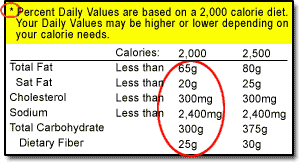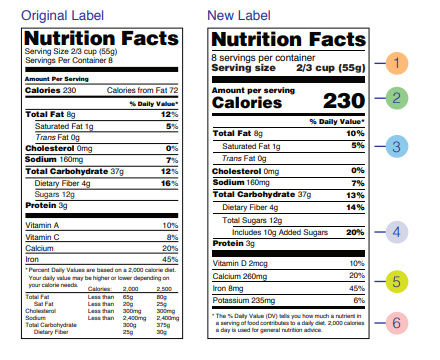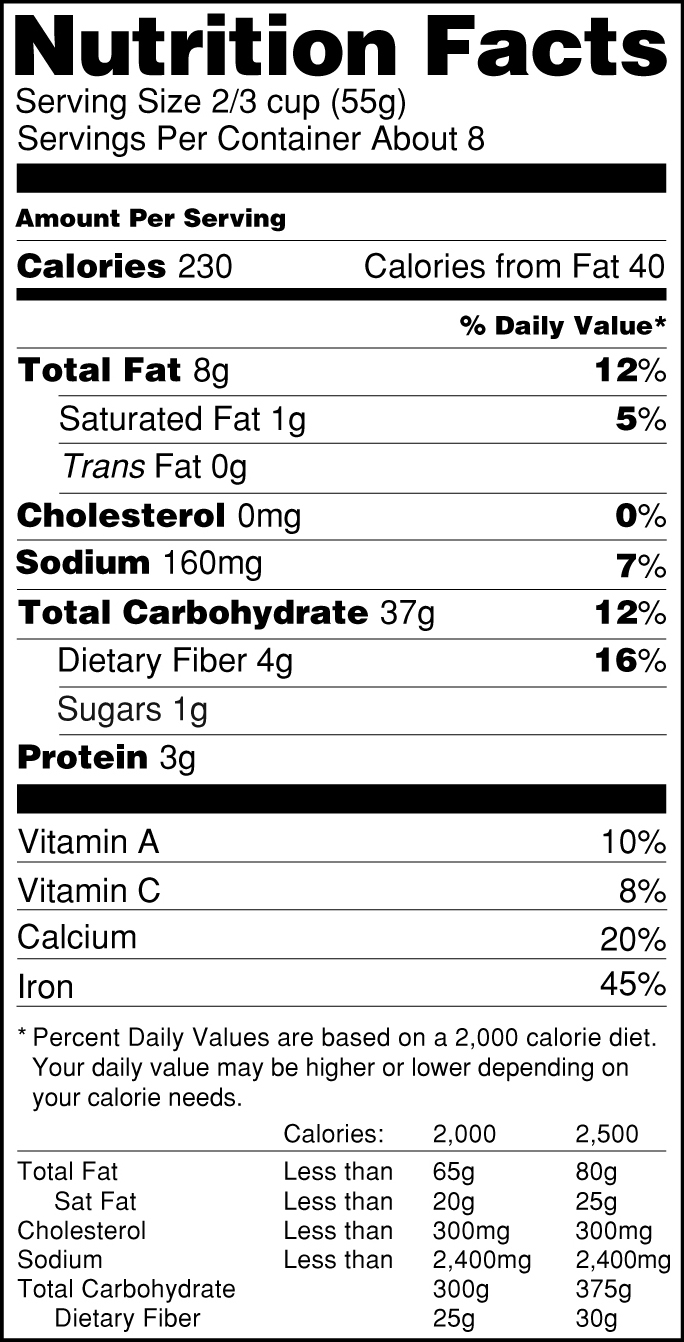41 daily value on food labels
Daily Values (DVs) - National Institutes of Health DVs were developed by the U.S. Food and Drug Administration (FDA) to help consumers determine the level of various nutrients in a standard serving of food in relation to their approximate requirement for it. The label actually provides the %DV so that you can see how much (what percentage) a serving of the product contributes to reaching the DV. Percent daily value - Canada.ca dividing the amount of a nutrient in a serving size by its daily value, then multiplying that number by 100 For example, a food product has 3 mg of iron. The daily value for iron is 14 mg. This means that the % DV for iron would be 21%. If you would like to do your own calculation, use the equation below to help you. (3 mg ÷ 14 mg) × 100 = 21% DV
Daily Value on the New Nutrition and Supplement Facts Labels (3) The Daily Value decrease for vitamin E applies for foods/supplements containing the natural form of vitamin E, but not for the synthetic form. For foods/supplements containing only the...

Daily value on food labels
How To Read Food and Beverage Labels - National Institute on Aging Understanding percent Daily Value (% DV) The percent Daily Value (% DV) tells how much a nutrient in a serving of the food or beverage contributes to a total daily 2,000-calorie diet. Although the average person needs 2,000 calories a day to maintain their weight, individuals may need more or fewer depending on their lifestyle. Daily Value: Definition and How to Calculate It - Insider Found on the nutrition label, the daily value system tells you can help you determine if a product is high or low in particular nutrients. What does daily value mean? Daily value (DV) refers to how much of a nutrient you should consume each day based on a 2,000 calorie diet. You can find daily values for a range of nutrients on the FDA's website. The Lows and Highs of Percent Daily Value on the Label 5% DV or less of a nutrient per serving is considered low. 20% DV or more of a nutrient per serving is considered high. More often, choose foods that are: Higher in dietary fiber, vitamin D,...
Daily value on food labels. How you can Calculate % of Daily Value on Food Labels How to Calculate % of Daily Value on Food Labels. Step 1. Find the nutrient amount on the food label. Step 2. Look up the total daily recommended amount in the USDA Dietary Guidelines. Step 3. Divide the nutrient amount by the total daily recommended value. Step 4. Learn About Percent Daily Value On Food Labels | Chegg.com Overview of Percent Daily Value on Food Labels. Based on a 2000-calorie diet for healthy individuals, the daily value (DVs) are based on a 1,000-calorie diet. However, a greater or lower caloric intake might still be used as guidance. For example, it informs if an item is high or poor in one or more nutrients. What are the daily values on food labels based on? - Short-Facts The % Daily Value (%DV) is the percentage of the Daily Value for each nutrient in a serving of the food. The Daily Values are reference amounts (expressed in grams, milligrams, or micrograms) of nutrients to consume or not to exceed each day. The %DV shows how much a nutrient in a serving of a food contributes to a total daily diet. Daily Value on the New Nutrition and Supplement Facts Labels (3) The Daily Value decrease for vitamin E applies for foods/supplements containing the natural form of vitamin E, but not for the synthetic form. For foods/supplements containing only the...
Added Sugars on the New Nutrition Facts Label | FDA The Dietary Guidelines for Americans recommends limiting calories from added sugars to less than 10 percent of total calories per day. For example, if you consume a 2,000 calorie daily diet, that ... Food Labels | CDC - Centers for Disease Control and Prevention In general, eat more foods that are higher in vitamins, minerals (such as calcium and iron), and fiber. Eat fewer foods that are higher in added sugars, saturated fat, and sodium (salt), and avoid trans fat. Keep in mind that the % Daily Value of each nutrient, such as total fat of 10% in the example below, is based on eating 2,000 calories a day. How to Calculate % of Daily Value on Food Labels | livestrong People often say they want to eat healthier. One of the first steps to take is examining nutritional value prior to purchasing foods. Food labels include most relevant information, including calories, fat, protein, and carbohydrate content. Vitamin and mineral levels are also included. Understanding Labels - 4. The Percent Daily Value (%DV) (#4 on sample ... 4. The Percent Daily Value (%DV) (#4 on sample label) The % Daily Value (%DV) is the percentage of the Daily Value for each nutrient in a serving of the food. The Daily Values are reference amounts (expressed in grams, milligrams, or micrograms) of nutrients to consume or not to exceed each day. The %DV shows how much a nutrient in a serving of ...
What Does "% Daily Value" Mean on a Food or Supplement Label? The U.S. Food and Drug Administration (FDA) recommends 400 IU, so that's what the Daily Value is set at. The Institute of Medicine recommends getting between 600 and 800 IU per day (as does Health Canada ). Dr. Oz recommends 1,000 IU. Dr. Andrew Weil recommends 2,000 IU. The Linus Pauling Institute recommends 2,000 IU. Learn About Daily Values On Food Labels | Chegg.com Daily value (DV) food labels are present on almost every packaged food or drink container. Every label contains product-specific information. A standard nutrient label includes various information on ingredients like the serving size, number of calories, saturated fat, trans fat, total grams of fat, cholesterol, sodium, total carbohydrates, dietary fibers, sugars, proteins, calcium, iron, and ... Daily Values | Dietary Supplement Label Database (DSLD) | NIH Office of ... Daily Value on the New Nutrition and Supplement Facts Labels Nutrient Unit Conversion Factors The Daily Values (DVs) that are used to declare vitamins and minerals on labels have been updated in the new regulations. Also updated are the units to express the amounts of the fat-soluble vitamins A, D and E, and folate. Table of Daily Values - Canada.ca This document is a two-part table that sets out the recommended amounts of nutrients (the daily value) for specific age groups. These are the reference points upon which the % daily value in the nutrition facts table are based. Part 1 of the table sets out the daily values for macronutrients and sodium for two age groups.
How to Understand and Use the Nutrition Facts Label | FDA The % Daily Value (%DV) is the percentage of the Daily Value for each nutrient in a serving of the food. The Daily Values are reference amounts (expressed in grams, milligrams, or...
Percent Daily Value On Food Label - LabelCal What are Percent Daily Values on Food Labels? Percent daily values represent the percentage of the recommended daily intake a single serving of food contains. For instance, if the percent daily value for saturated fat is 45%, that means you are getting almost half of the saturated fat that the FDA recommends you consume in one day.
The Lows and Highs of Percent Daily Value on the Label 5% DV or less of a nutrient per serving is considered low. 20% DV or more of a nutrient per serving is considered high. More often, choose foods that are: Higher in dietary fiber, vitamin D,...
Daily Value: Definition and How to Calculate It - Insider Found on the nutrition label, the daily value system tells you can help you determine if a product is high or low in particular nutrients. What does daily value mean? Daily value (DV) refers to how much of a nutrient you should consume each day based on a 2,000 calorie diet. You can find daily values for a range of nutrients on the FDA's website.
How To Read Food and Beverage Labels - National Institute on Aging Understanding percent Daily Value (% DV) The percent Daily Value (% DV) tells how much a nutrient in a serving of the food or beverage contributes to a total daily 2,000-calorie diet. Although the average person needs 2,000 calories a day to maintain their weight, individuals may need more or fewer depending on their lifestyle.




































Post a Comment for "41 daily value on food labels"